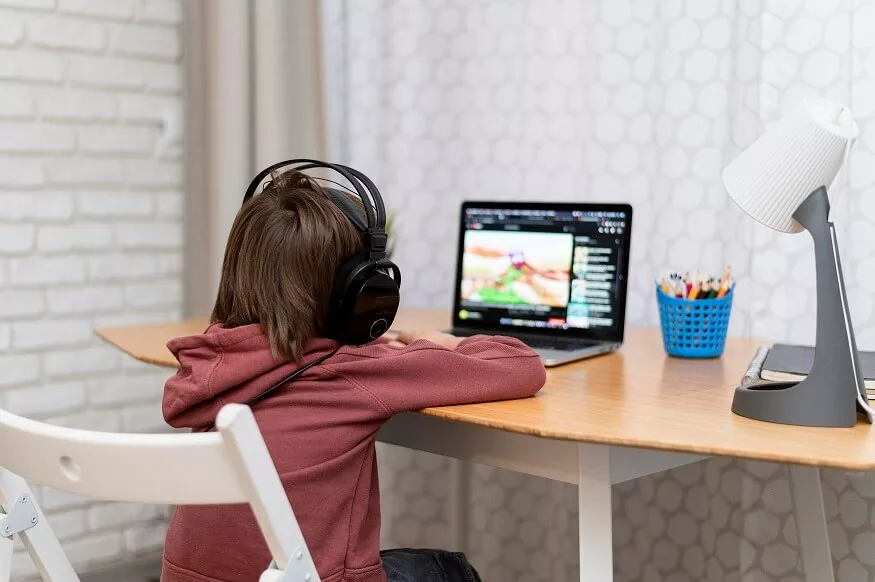Children get more exposed to screens than ever before in today’s digital environment. Screens have become an essential component of parenting, particularly for educational, entertainment, and communication purposes. However, if not controlled effectively, excessive screen time may be harmful to children’s health, particularly their posture. This blog discusses the significance of keeping a correct body posture during children’s screen time, as well as the multiple advantages it provides.
The Impact of Prolonged Screen Time on Children’s Posture:
Prolonged screen time can have a detrimental impact on a child’s posture. Here are some of the common posture-related issues associated with excessive screen use:
- Forward Head Posture: Children often lean forward when using screens, causing their heads to just forward. This can strain the neck and shoulder muscles and lead to a forward head posture, which can result in long-term neck and back problems.
- Rounded Shoulders: Slouching while using screens is a common habit among children. This slouched posture can lead to rounded shoulders, affecting the natural alignment of the spine and causing discomfort.
- Reduced Physical Activity: Excessive screen time often replaces physical activities such as playing outside, sports, or other forms of exercise. This lack of physical exercise can cause structural difficulties by weakening the muscles that promote proper posture while sitting.
- Eye Strain: Long durations of staring at screens may cause eye strain and discomfort, leading to bad posture as youngsters try to find a more comfortable viewing position.
- Increased Sedentary Behaviour: Longer screen time encourages sedentary behaviour, which can lead to obesity and musculoskeletal problems, such as bad posture.
Also Read: Effective Tips to Reduce Screen Time
Tips for Healthy Posture During Screen Time:
Parents can take bold steps to check that children maintain a healthy posture during screen time. Here are some essential tips:
- Ergonomic Workstations: Set up a comfortable workplace for your child. To encourage healthy posture, make sure the screen is at eye level, the chair is at the perfect height, and the keyboard and mouse are within easy access.
- Limit Screen Time: Establish guidelines for screen time, ensuring that children have adequate breaks from screens. The American Academy of Paediatrics recommends that children aged 6 and above limit their personal screen usage to no more than 2 hours per day.
- Encourage Breaks: Encourage children to take short breaks every 20-30 minutes while using screens. During these breaks, they can stretch, walk around, and do some light exercises to prevent stiffness.
- Provide Proper Seating: Use chairs that provide good lumbar support to maintain the natural curve of the spine. Avoid soft and cushioned seating that can encourage slouching.
- Monitor Screen Distance: Make sure the screen is at a comfortable distance from the child’s eyes to avoid them bending in and straining their neck and shoulders.
- Teach Postural Awareness: Inform kids about the significance of excellent posture. Teach them to sit up straight and head straight to the spine.
- Physical Activities: Encourage your children to participate in physical activities and to exercise regularly. Strong core muscles and a healthy body weight aid in better posture.
- Consider a Standing Desk: Standing desks can be an excellent option for children, as they encourage more movement and better posture. However, it’s important to ensure that the desk and monitor height are suitable for the child’s height.
- Supportive Pillows and Cushions: Use supportive pillows and cushions if needed to help children maintain good posture while sitting or lying down with screens.
The Benefit of Good Posture for Children:
Promoting and maintaining healthy posture during children’s screen time offers a wide range of benefits:
- Reduced Risk of Muscle Issues: Proper body posture lowers the risk of getting musculoskeletal problems such back pain, neck pain, and imbalanced muscles. A child who sits in a curved position for an extended amount of time, such as when using a computer, may have lower back pain and discomfort. They avoid such issues by keeping proper body posture, which reduces back stress.
- Enhanced Learning and Focus: Children with proper body posture are better able to concentrate, which is essential for effective learning and improved academic performance. Example: A child who maintains a slouched posture restricts their lung capacity, which can lead to shallow breathing and decreased oxygen intake. In contrast, a child with correct body posture can breathe deeply, promoting better respiratory health.
- Improved Confidence and Self Esteem: Children who stand and sit with correct body posture show confidence and have greater self-esteem. A teenager who is self-conscious may discover that changing their posture not only reduces physical discomfort but also makes them feel more confident in social situations and when engaging in activities.
- Better Respiratory Health: Proper posture while sitting allows for optimal lung function and oxygen intake, promoting respiratory health.
- Prevention of Chronic Health Issues: Teaching children to maintain healthy posture from a young age helps prevent chronic health issues in adulthood, such as spinal deformities and chronic pain.
- Positive Social Interaction: One of the benefits of good posture may improve a child’s social interaction and communication capacities by showing confidence and strength.
- Improved Physical Well Being: Children with excellent posture are more likely to participate in physical activities, which leads to improved physical well-being and general health.
- Emotional Well Being: Proper posture while sitting can improve a child’s emotional well-being by lowering stress and worry.
- Long Term Health advantages: Maintaining proper posture while sitting from childhood lays the groundwork for a lifetime of excellent posture and its related health advantages.
- Prevention of Computer Vision Syndrome: Healthy posture contributes to preventing computer vision syndrome, a condition characterized by eye strain and discomfort due to prolonged screen use. Example: A child who maintains an appropriate screen-to-eye distance and takes regular breaks during screen time can significantly reduce the risk of experiencing computer vision syndrome symptoms like eye strain, dry eyes, and headaches.
Also Read: 5 Reasons Why You Need to Reduce Your Teen’s Screen Time
At EuroSchool, we understand the importance of maintaining a healthy posture that is correct body posture during children’s screen time. Parents, kids and teachers also should be aware of maintaining a proper posture while sitting. It is also vital for parents to check that their children get enough physical activity, sleep, and playtime.










